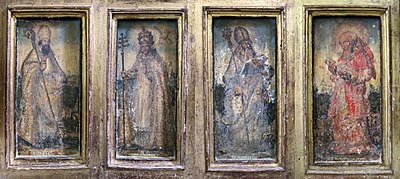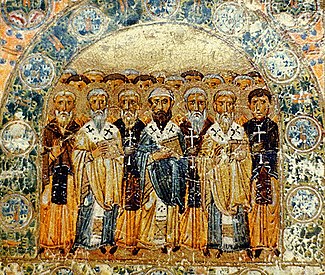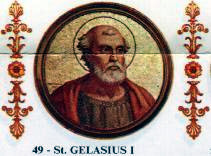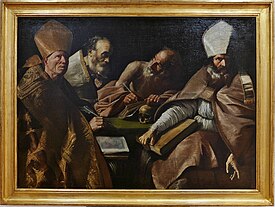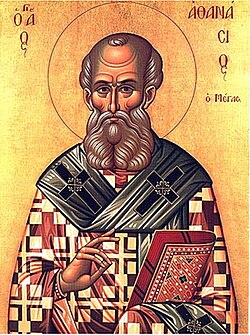Church Fathers
The Church Fathers, also known as Holy Fathers, Early Church Fathers, Christian Fathers > are a group of priests, theologians and Christian ecclesiastical writers, mostly bishops, ranging from the 1st to the 8th century, and whose body of doctrine is considered a testimony of faith and orthodoxy in Christianity. For several branches of Protestantism, the writings emanating from patristics are eminently testimonial, corroborative to the extent that they are submitted to a solid exegesis of the Bible.
In traditional dogmatic theology, authors considered Church Fathers are treated as authoritative, and a somewhat restrictive definition is used. The academic field of patristics, the study of the Church Fathers, has expanded the scope of the term, and there is no definitive list. Some, such as Origen and Tertullian, made important contributions to the development of later Christian theology, but certain elements of his teaching were later condemned.
Introduction
The Fathers of the Church are a group of writers whose teachings had great weight in the development of Christian thought and theology according to their interpretation of the Bible, the incorporation of Tradition and the consolidation of the Liturgy, so they left a doctrine together. It is their commonalities that are taken into account.
The Fathers of the Church often had to respond to emerging questions and difficulties, raised by morality and theology, in the midst of an environment convulsed by external persecutions and internal conflicts caused by heresies and schisms of the post-apostolic Church.
For this reason, they are considered as the immediate continuators of the work that the apostles had started, and those who came to advantageously replace them, since they left ample testimony of their work and teachings, writings often directly supported by the ecclesiastical hierarchy headed by the pope.
The "parents" title for this group appeared as early as the IV century, such as can be seen in the words of Basil of Caesarea: "What we teach is not the result of our personal reflections, but what we have learned from the Fathers".
Pope Gelasius I drew up the first official list of the Church Fathers. From there, two new sciences have emerged in relation to its study, closely related to each other:
- The study and analysis of the work of these writers is called Patristics.
- The study of the life and person of the parents is called Pathology.
These two sciences have established a classification by generations and cultural origins, in order to facilitate a more accurate understanding of the development of Christian theology exposed by them.
The Apostolic Fathers
Apostolic Fathers is the denomination that, since the XVII century, those first Church Fathers who were immediately close to the apostles of Jesus Christ, so they are chronologically located in the century. I and first half of the century II. His writings are specific responses to ecclesial communities, most of them moral content rather than doctrinal, in the form of letters, documents or recommendations, so his style is simple and direct.
Among these writers we count Clement of Rome, Ignatius of Antioch, Papias of Hierapolis, Polycarp of Smyrna, and the authors (so far unknown) of the Didache, the Letter to Diognetus and the Shepherd of Hermas.
The Apologist Fathers
Apologist Fathers refer to those Church Fathers who emerged from the late 19th century II d. C., when with the death of the disciples of the apostles the most direct references to the life of Jesus and the origins of the apostolic age were extinguished. At this stage, Christians only had the Scriptures and the Apostolic Tradition as a reference, and for this reason they struggled to face the dangers that threatened the very existence of the nascent Church. The Apologist Fathers were in charge of defending Christianity at a time when, in addition to the persecutions of the civil authorities, new theological approaches arose on the part of Gentiles, and members of the Church itself.
The sacred writers, since the death of this generation, only had the testimony of the Sacred Scriptures, the Liturgy and the Tradition maintained in each of the particular Churches.
These first generations of Christian writers still lived under persecution and are known as Apologists for their defense of Christianity against pagans or Gentiles and other doctrines of the time. Among them are Justin Martyr, Irenaeus of Lyon, Hippolytus of Rome, Novatian, Tertullian; forming the School of Alexandria, Origen —the father of Theology—, Panteno, Cipriano de Carthage and Clement of Alexandria; and, from the School of Antioquia, Luciano de Antioquia.
The inclusion of some authors, either as apologists or as fathers of the Church, depends more on study criteria than on generational reasons.
Church Fathers
In principle, the designation Church Fathers was kept for four fathers of the Eastern Church; later four others from the Latin or Western Church were added. These were also called Greek or Latin fathers according to the language in which they wrote their works.
The four Greek Church Fathers are:
- Athanasius of Alexandria
- The Great Basil
- Gregorio Nacianceno
- Juan Crisóstomo
And the four Latin Church Fathers are:
- Ambrose of Milan
- Jerónimo de Estridón
- Agustín de Hipona
- Gregorio Magno
However, the Church Fathers are also known as a broader series of Christian writers, who lived through the 20th century III to the VIII century, and which are characterized by the orthodoxy of their doctrine, holiness of life and recognition by the Church. Its golden age was the IV and V and flourished both in the West, where they wrote in Latin, and in the East, where they wrote in Greek, Syriac, Coptic, Armenian, Georgian and Arabic. In their works they use Greek and Latin culture to explain Christian mysteries.
The Oriental Fathers
The four Eastern Fathers are also known interchangeably as the four Greek Fathers or as the four Church Fathers of the Greek rite (ie, of the Eastern Church or of the Eastern Catholic Churches).
The oldest of these is Athanasius of Alexandria (295–373), Bishop of Alexandria, who played an important role in the Council of Nicaea I; then the "great Cappadocians" stand out, a common title of the brothers Basilio the Great (329-379) and Gregory of Nisa (335-394), as well as their friend Gregory of Nazianzo (†389), who wrote abundantly against the Arian heresy.
In the eastern part of the Roman Empire, two very important theological schools developed later around the Patriarchate of Antioch —whose main representative is John Chrysostom (344–407), Patriarch of Constantinople, famous for his homilies—; and of the Patriarchate of Alexandria, with Cyril of Alexandria (380-444), defender of the divine motherhood of Mary at the Council of Ephesus.
The cycle of the four oriental fathers was closed by John Damascene (675–749), an acute theologian who, in addition to fighting against Manichaeism and superstition, announced almost five centuries before the incorporation of Aristotle's thought into Christian philosophy.
The Western Fathers
The four Western Fathers are also known as the four Latin Fathers or four Church Fathers of the Latin rite (that is, of the Western Church or of the Catholic Church). Among them are Ambrose of Milan (333–397), a composer of great hymns and a highly influential person; He baptized what was to be the greatest of them all, Augustine of Hippo (354-430), a leading figure in Christian history and one of the most important thinkers in universal history; Jerome of Estridón (342-420), distinguished cultivator of history and Sacred Scripture, left us his famous Vulgate, the Bible directly translated from Hebrew and Greek into Latin; and to the pope: Gregory the Great (540–604).
Other Western parents
The Western Church includes Pope Leo I the Great (†461); the father of western monasticism Benedict of Nursia; various bishops from Gaul, such as Cesáreo de Arles (470–543), who formulated the Dogma of Grace; Gregory of Tours; Hillary of Poitiers; the group of Hispanic fathers, in which Osio de Córdoba stands out; Martin de Braga; and the brothers Leandro de Sevilla (†600) and Isidoro de Sevilla (560–636), author of the first Christian encyclopedia, entitled Etymologies; and, closing the cycle, the Englishman Bede the Venerable (673-735), continuer of the wise work of Isidore of Seville.
In addition to the Church Fathers, both of the Eastern and Western rites, patristics studies the work of many other Christian writers who have also received the title of "Church Fathers." The abundant work of these writers continues to be through the centuries a safe reference in the approach of the ideas and teachings of the Church.
List of the fathers of the Church
The following table lists the main Church Fathers in alphabetical order with their date of death in parentheses.
| Greek Fathers | Latin Fathers |
| Andrés de Creta (f. 740) | Ambrose of Milan (f. 397) |
| Afraates (centuryIV) | Arnobio de Sicca (f. 330) |
| San Arquelao (f. 282) | Agustín de Hipona (f. 430) |
| Athanasius of Alexandria (f. 373) | Benito de Nursia (f. 550) |
| Anastasio Sinaita (f. 700) | Cessareo de Arlés (f. 542) |
| Athenagoras of Athens (centuryII) | Juan Casiano (f. 435) |
| Basil Magno (f. 379) | Celestino I (f. 432) |
| Cessareo de Nacianzo (f. 369) | Cornelius (f. 253) |
| Clement of Alexandria (f. 215) | Cipriano de Cartago (f. 258) |
| Clemente Romano (f. 97) | Damage (f. 384) |
| Cyril of Alexandria (f. 444) | Dionysium (f. 268) |
| Cyril of Jerusalem (f. 386) | Enodio de Pavia (f. 521) |
| I said the Blind (f. 398) | Euquiry of Lyon (f. 450) |
| Diodoro de Tarso (f. 392) | Fulgencio (f. 533) |
| Dionysius the Great (f. 264) | Gregorio de Elvira (f. 392) |
| Syria (f. 373) | Gregorio Magno (f. 604) |
| Epiphany (f. 403) | Hilary of Poitiers (f. 367) |
| Eusebius of Cesarea (f. 340) | Ildefonso de Toledo (f. 667) |
| Eustatius of Antioch (f. century)IV) | Inocencio de Roma (f. 417) |
| Signature of Cesarea (f. 268) | Ireneo de Lyon (f. 202) |
| Genadio I of ConstantinopleV) | Isidoro de Sevilla (f. 636) (last of Western parents) |
| Germano I de Constantinople (f. 732) | Jerónimo de Estridón (f. 420) |
| Gregorio de Nacianzo (f. 390) | Lactancy (f. 323) |
| Gregorio de Nisa (f. 395) | Leandro de Sevilla (f. 600) |
| Gregorio Taumaturgo (f. 268) | Pope Leo Magno (f. 461) |
| Hermes of Rome (centuryII) | Mario Mercátor (f. 451) |
| Hippolyte of Rome (f. 236) | Mario Victorino (f. h. 382)) |
| Ignatius of Antioch (f. 107) | Martín de Braga (f. 579) |
| Isidore de Pelusio (f. 450) | Minucio Félix (sixth century)II) |
| Juan Crisóstomo (f. 407) | Novatian (f. 257) |
| Juan Clímaco (f. 649) | Optato (centuryIV) |
| Juan Damasceno (f. 749) (the last of the Eastern parents) | Osio de Córdoba (f. 357) |
| Papa Julio I (f. 352) | Paciano (f. 390) |
| Justin Martyr (f. 165) | Pánfilo de Cesarea (f. 309) |
| Leoncio de Byzancio (seventh centuryVI) | Paulino de Nola (f. 431) |
| Macario el Viejo (f. 390) | Pedro Crisologist (f. 450) |
| Maximum Confessor (f. 662) | Febadium (f. century)IV) |
| Meliton of Sardes (f. 180) | Achile Ruffin (f. 410) |
| Olympus Methodius (f. 311) | Salvian (centuryV) |
| Nile the Old (f. 430) | Pope Siricio (f. 399) |
| Origins (f. 254) | Tertullian (f. 222) |
| Policarpo de Esmirna (f. 155) | Venancio Fortunato (f. 610) |
| Proclo de Constantinople (f. 446) | Vicente de Lerins (f. 450) |
| Pseudo Dionisio Areopagite (sixteenth centuryVI) | |
| Serapion (f. 370) | |
| Sophronium (f. 638) | |
| Taciano (centuryII) | |
| Mopsuestia Teodoro (f. 428) | |
| Cyrus Theodoret (f. 458) | |
| Theophile of Antioch (sixteenth centuryII) | Note: Sometimes the list of Latin parents is added to Beda el Venerable (f. 735) |
Contenido relacionado
Luis Carrero Blanco
Vulgate
Heraldry
